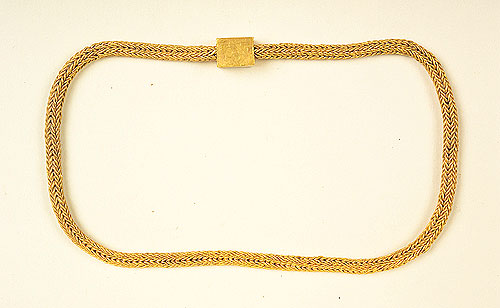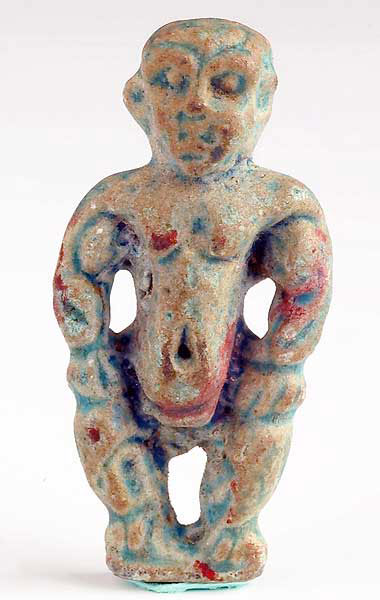Hollowed-out Flower-shaped Gold Balls
Eastern Han Dynasty (25AD - 220AD)
Diameter: 1-1.5cm; Weight: 40g
Unearthed from Tomb No. 9 at Lijialaowu, Wulipai, Changsha city in 1959
These eleven gold balls consist of three shapes: oblate, hexagonal and round. They are made into the ball shape from thin gold leaf. The surrounding ornaments are made from thin gold threads. On the surface of some of the balls are the petals and tiny gold beads made from the welded gold threads. Some are made by welding the gold rings, on the surface of which are decorated with sesame-sized gold beads. They look like the kernels of the corn in a regular formation. With such exquisite design and superb craftsmanship, they are the masterpieces among the gold ornaments.
Author: Wang Hui
深入探索
The Craftsmanship of Making Gold Beads
The technique of welding the gold beads refers to such a process in which the short and tiny gold threads are fused after being heated so as to form small beads. When they are tiny, they would be round-shaped. When a little bigger in size, they should be shaped into round ones with the use of two wooden boards. Another method is that after heating one end of the gold thread, the maker could use a little pipe to blow cold air to it, which would blow the fused end into small beads and let them drop. Sometimes, the small beads would stay on the end in order to be used for other purposes. The third method is a unique technique, which is called “melting beads”. In this process, the liquid form of the gold is poured into warm water, thus forming gold beads of various sizes as they coagulate. These gold beads can be welded or pasted, thus having high value.
The artifacts made with the craftsmanship of gold beads first appeared at the late Warring States Period and some have been unearthed in Gansu, Xinjiang, Inner Mongolia, Hebei, Shandong and other provinces. Judging from the cultural nature of the historical sites, they are closely related to the grassland culture in northern part of China as they demonstrate the unique artistic features of the grassland culture.
At the Western Han Dynasty, the varieties and amount of artifacts of gold beads unearthed in China increased tremendously. From the unique shapes of those artworks, which could only be made in China, it could be concluded that Chinese goldsmiths had already mastered the technique of processing the natural gold into small gold beads for ornamentation. They were real “made in China” products. Up to now, the artworks of gold beads of Western Han dynasty have been found in the following provinces, including Shannxi, Hebei, Shandong, Xinjiang, Guangdong and so on. However, Guangdong is the only province that lies in the southern part of China. The gold ornament on the dress of the tomb’s occupant of the Tomb of the King of Southern Yue is made with welding gold beads technique. But no similar ornaments could be found in northern part of China. This proves that the manufacturing techniques of the north and south in China could have different origins.
Up to now, over 40 pieces of multi-faceted gold beads of Eastern Han Dynasty have been unearthed, mainly from Jiangsu, Anhui, Hunan, Guangxi and Guangdong provinces. Those hollowed-out gold balls unearthed from Tomb No. 9 at Lijialaowu, Wulipai, Changsha city dating back to Eastern Han Dynasty are multi-faceted. They are made by welding 12 to 14 gold rings. At the welding point is decorated with one or four gold beads. Such a practice is similar to that one employed on the artifacts unearthed from the tomb of the king of Southern Yue State. The most noticeable feature of the gold beads is that they are of unique shapes, produced by either filigree or welding gold beads. Their shapes and craftsmanship are beyond the traditional Chinese styles, thus proving that they could be imported from foreign lands. Multi-faceted gold balls at Eastern Han Dynasty or earlier periods were rarely found in the northern part of China. However, they were unearthed in Pakistan and Vietnam, dating back to the same period as China’s Eastern Han Dynasty. In addition, such a technique enjoys even longer history in Greece and Central Asia. In China, Hepu county in Guangxi Zhuang Autonomous Region boasts the largest number of unearthed gold balls. During Han Dynasty, it was an important hub on the marine trade route between the West and the East. Therefore, it is concluded that the technique of making multi-faceted gold balls could possibly be introduced to the Southern part of China via the marine trade.

Rope-shaped Gold Chain
Eastern Han Dynasty (25AD - 220AD)
Length: 19.4cm; Weight: 12.8g
Unearthed from Tomb No. 9 at Lijialaowu, Wulipai, Changsha city in 1959
Collected by Hunan Provincial Museum

Gold ornaments
Eastern Han Dynasty (25AD - 220AD)
Length: 2.5-1.3cm; Width: 1.4-0.3cm
Unearthed from Nanping town, Changde city in 1977
Collected by Changde Museum

The bronze horse and the bronze figurine of Hu (the Northern tribes in ancient China)
Eastern Han Dynasty (25AD - 220AD)
Height of the horse: 51.1cm; Length: 45cm; Weight: 12.15kg
Height of the figurine: 43cm; Weight: 6kg
Unearthed from Tomb No.1, Daoziping, Hengyang County in 1976
Collected by Hunan Provincial Museum

Green glazed porcelain figurine
Eastern Han Dynasty (25AD - 220AD)
Width at its shoulder: 1.3cm; Height: 3cm
Originally collected by Hunan Provincial Cultural Relics Management Committee
Then collected by Hunan Provincial Museum in 1958
相关评论
1、陈松长: 《湖南出土金银器略说》 ,《收藏家》,2002年10期
2、吴既: 《从中国的金珠工艺制品看东西方文化交流》 ,《大众文艺》2013年06期




